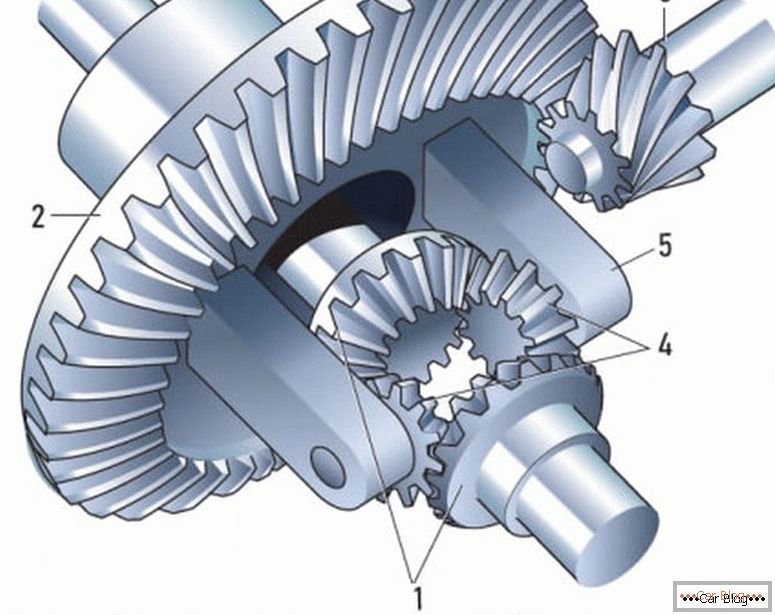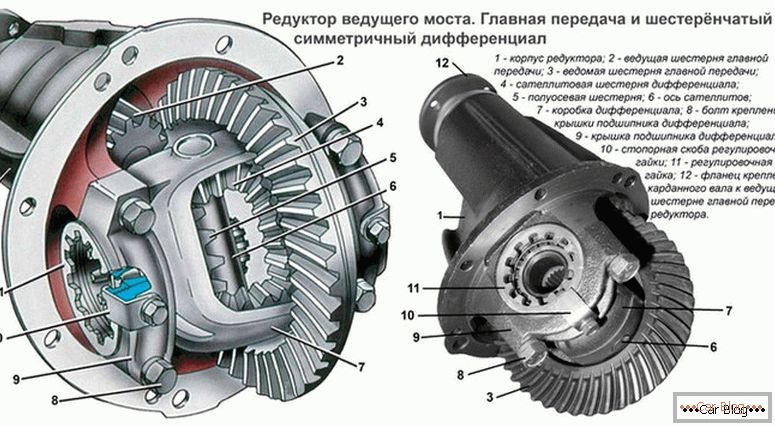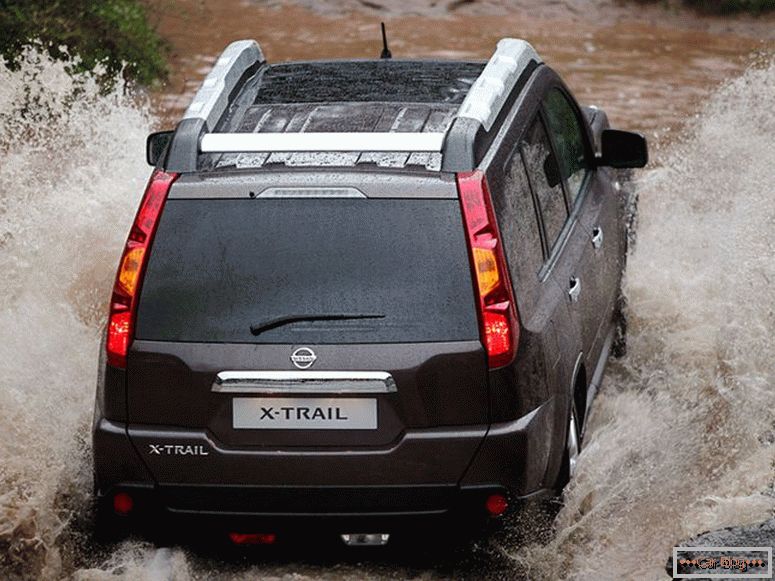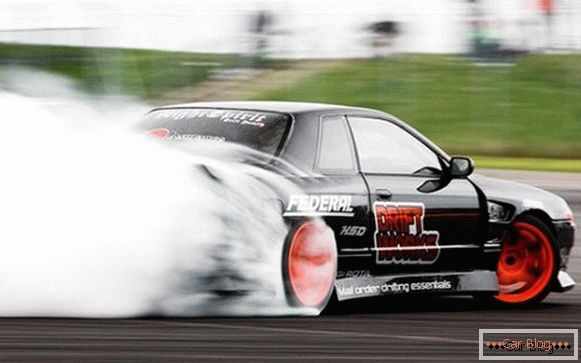Modern cars include a large number of nodes that ensure the efficiency of transport. Most of them are aimed at transferring the power moment from the engine to the wheels. An important role in this chain is played by the differential.
To see such a node, you need to look directly under the bottom. To know what a differential is in a car is not only for those involved in repairing machinery, but also for those who are committed to good machine control.
Content
- 1 What is the differential in the car?
- 2 How does the differential car
- 3 How is the differential
- 4 Variety of construction types
What is the differential in the car?
The mechanism is embedded in the vehicle in order to provide the pair of drive wheels with a possible rotational speed. This method minimizes the possibility of slippage on both sides and increases the patency of the car on problem areas of roads.
When entering a corner or when driving on an uneven surface, each of the wheels on a driving axle travels along a different length. Without differentials, tires will slip across the surface. It is possible to eliminate the resulting effect only if they are provided with a different rotation speed. For this purpose, the built-in differential is used.

This gear mechanism not only gives different speeds to the tires, but also distributes torque in the right proportions to each side (semi-axle). It refers to the main structural elements of the transmission and is mounted by engineers at various points in the car:
- for front-wheel drive car installation is carried out in a checkpoint;
- rear-wheel drive vehicles have such a gear in the rear axle housing;
- AWD models get a pair of differentials into the crankcase of both the front and rear axle;
- A car with four driving wheels is equipped with a demanded node traditionally in a razdatka.
On machines with a single driving axle, structural assembly is carried out in the span of the wheel drives. This allows you to call the node cross-axle. Those who are interested in the center differential, what it is, you should know that it is installed in cars with 4x4 wheel formula. In all-wheel drive vehicles, it connects both driving axles.
Как работает дифференциал автомобиля
The nature of the functioning of the gear assembly is almost identical in all designs. The working division of the power moment at the crucial moment is made in such cases:
- in the process of rectilinear movement of a passenger car or truck;
- when the driver makes a turn;
- from the possible slippage of the car.
In the process of direct following on the road of the car between the semi-axes, the torque force from the engine is distributed in equal proportions. In this case, both disks receive an equivalent angular velocity. Built-in satellites in the body do not receive rotation around its axis. There is a return of torque to each of the semi-axes from the driven gear of the main gear through a fixed six-gear engagement.
See also: Equal angular velocity hinge: what is it
Turning the car allows the differential to distribute the force and speed received from the motor in the autonomous mode and redistribute it according to the following scheme:
- since the inner wheel goes along a small radial circle, and also it is subject to substantially greater resistance than its pair, the increased load forces it to lower the rotation speed;
- for a wheel moving along an increased radius from the outside, the value of the angular velocity increases, which allows the machine to overcome turns smoothly without slipping.
Based on the resulting kinematic scheme, each wheel of the leading pair rotates with its angular speed. For slowing down the rotation of the tire from the inner radius meet the driven satellites. Due to the special design of this gearbox through bevel gears, the wheel speed increases from the outer radius. In this case, the main gear sends a stable torque all the time turning.
A car can move in a straight line, but at the same time, its wheels, while off-road or on a wet / slippery road, are capable of experiencing a diverse load. One of them, probably, loses high-quality coupling with a roadbed (there is a slipping), and the second turns out overloaded. The repetition of kinematics used in the process of rotation is physically duplicated.

However, in this case, the uneven distribution of the load entails negative factors. The less loaded side of this principle is able to get up to 100% of the entire load from the engine. A more stable semi-axis may lose its rotation and stop spinning.
It is necessary to struggle with a lack, introducing external influence by one of effective methods:
- set manual or automatic lock;
- Stability system is put on cars.
The second method is more progressive.
How is the differential
The basic component of the kinematic scheme of the node is the planetary gear. The device of the differential car without it is impossible because of the nature of the work. The main elements in the design are such components:
- semi-axle gears;
- durable metal housing;
- satellite gears.
A bunch of semi-axle gears with the body are provided by the satellites used as a planetary gearbox. In this case, the first gears are connected to semi-axles, on which indirectly the leading pair of wheels is mounted. Different models of differentials assume in their designs either four or two satellites. Most often, manufacturers conceive the design of two such gears.
The satellite pair is located inside the hull. It is sometimes called a cup or carrier.
The traditional destination for the element is the transmission by means of satellites of the working moment from the main gear to the gears on the semi-axes. They can in some sources be called sun gears.
See also: How to replace the boot of the inner CV jointThe latter are used in order to transfer the torque force due to the rotation to the drive wheels. Depending on the design, the right and left gears are capable of having an equal or unequal number of teeth. This feature is used in different types of differentials:
- for an asymmetric type of gearbox, a different number of teeth in the involute gearing will be relevant;
- in symmetric engagement, gears with an equal number of teeth will be required.
You can find out what type is in your car on the official website of the car company or in the instruction manual for the car.
Variety of construction types
It is worth knowing that there may be worm, bevel or cylindrical differentials. For wheels mounted on a single axis, a scheme with conical pairs is used. A cylindrical gearbox is installed for the center type. Worm variants are universal for use.
In addition to these three variants of the working scheme, other types are used:
- full lock differential;
- Viscous coupling;
- Thorsen differentials;
- Kvayf.
Full blocking is mainly in demand for cargo and off-road car models. To start the lock, control mechanisms from the passenger compartment are used directly by the driver. This option is relevant to improve the throughput of vehicles.
German engineers from Siemens were engaged in the development of Thorsen. In its essence, this type is a symbiosis of worm and bevel gears that serve a single purpose - the division of torque between the semi-axes.
In Quif it is stipulated that the satellites inside are two-row arranged parallel to the axis of rotation of the bowl. Also, during the active phase of performance, friction forces appear, due to which a blocking occurs automatically, which positively affects the vehicle’s permeability. The most frequent use of this design is found in the process of deep tuning of off-road cars and cars.
The use of Viscous coupling as a differential is the same as the operation of a torque converter. There is such a design in all-wheel drive vehicles. There she acts as a link for the front and rear wheel pairs. When one of them slip, the second get rid of the slip.
The design of such a differential is hidden in the cylinder. Inside in a viscous fluid is a package of metal discs with small perforations and interconnected shafts (master / slave). Due to a change in temperature, a change in viscosity occurs, which is fundamental for the operation of this structural unit.



